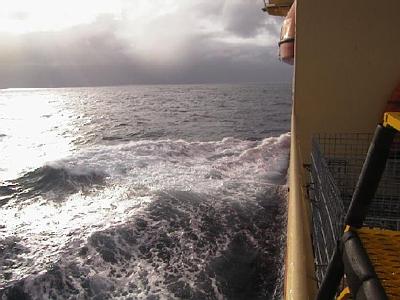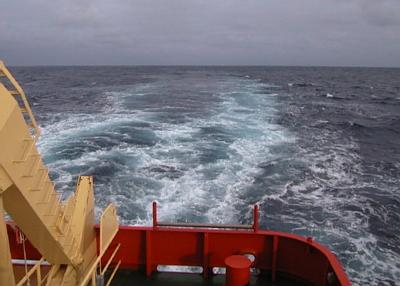
|
|
30 March, 2000
The Big Thaw
56 34 s, 64 35 w
In Drake Passage 299 nautical miles (344 miles) south of Puentas Arenas, Chile
Temp +4 C (39 F), winds S @ 12 knots (14 mph), barometer 1000 mb, steady
Seas 2-3 m (7-10 ft), depth 3049m (10,001 ft.)
Course 354 @12 knots
Early this morning we passed the Antarctic Convergence, and as
soon as I went out on deck I knew it. There are no signposts marking the
line. Before it, we saw waves, sky, birds and open ocean. After it we saw
waves, sky, birds and open ocean. But it is a definite boundary.
The Antarctic Convergence is a circle surrounding Antarctica, a
line where cold, northwest flowing water from the seas surrounding
Antarctica sinks. It slides under warmer southeast flowing water from the
north. It's not a perfect circle; its latitude varies with longitude and
with the seasons, but is usually found between 50 s and 60 s. It cuts down
the middle of the Drake Passage.
What is it like to cross it? Did I feel a bump, or see a line? No,
but all of a sudden, within an hour or so, everything got a lot warmer, the
ocean, the air, the ship, and myself. The air had a softer feel to it, and
the air temperature rose a few degrees. The water temperature also went up.
In the Amundsen Sea it was commonly almost 2 C (28 F.) I just looked at the
gauge and it is +3.5 C (38 F) now. The water seems a little grayer and a
little bit less blue. Even the clouds seem softer and more diffuse.
I've been on boats at the edge of the Gulf Stream, that large
river of warm water that flows north along the coast of New England. I
noticed the same kind of change entering the Gulf Stream.
Antarctica really begins and ends at the convergence. The open
ocean which surrounds the poles, and the ring of winds that circle the
continent, keep Antarctica in its perpetual deep freeze. Crossing the
convergence is like coming out of a walk-in freezer into a summer day.
Antarctica wasn't always locked up in a ring of cold. Oxygen
isotope records from the bottom of the Pacific Ocean give scientists a
history of the size of world ice caps. They show that for a long time, up
until about fifteen million years ago, there was no big two-mile thick cake
of ice covering Antarctica. There were trees, flowers, streams and land
animals (but no people). Then things started getting colder. First,
glaciers covered East Antarctica, then about 2-3 million years ago West
Antarctica became covered. Since then the ice caps have pulsed, tripling
their size and then contracting every 120,000 years or so, but never
disappearing completely. During the coldest times, much of the land in the
northern hemisphere was ice covered. We passed the warmest part of a cycle
about 9000 years ago, and in the long run things should get colder for the
next one hundred thousand years.
Scientists have a lot of theories as to why these cycles happen, and what
effect human activities are having on them. Right now, though, there is no
clear understanding and agreement among scientists as to what makes
climates change, on a short or long time scale. There are some guesses.
Maybe the strength of the sun changes. Maybe the orbital (Milankovitch)
cycles of the sun cause the variation. Or it could be periodic rising and
subsidence of mountains, or dust or carbon dioxide from volcanoes. Or a
combination of these, or something nobody has thought of yet. There is no
one clear theory yet.
From our present position we have about 30 hours of travel time to Puentas
Arenas. We'll pass Cape Horn on our left (port) side, and then enter the
Strait of Magellan from the east. Just inside the entrance of the Strait we
will pick up a pilot, who will guide us into port. I am going to spend a
few days hiking in southern Chile, and then fly through Santiago, Miami,
and Boston to my home near Bangor, Maine.
Passing the Antarctic Convergence seems to be a good point to end this
journal. I have to pack and clean the room where I've lived for the past
month and a half. I've got to get pictures and data organized, and help
prepare samples for shipping. I also want a chance to say good bye to some
of the people who have shared this adventure with me. Oh, and I almost
forgot. I've got at least one back journal entry, from earlier this week,
to edit and post. I've been putting that off, like back homework, but it's
a good one so don't miss it.
If you want to contact me, and I hope you will keep doing so, this e-mail
address won't work after April 1, and nothing can be forwarded. It would be
best to use my home e-mail which is: ler@mint.net
I also want to say thank you to all the people, crew and scientists, aboard
the Nathaniel B. Palmer, who have put up with all my questions. Of course
I'm also grateful to Tom and Davida Kellogg who gave me the chance to get
here in the first place. Another thank you goes to the National Science
Foundation's Teachers Experiencing Antarctica program, especially to Dr.
Stephanie Shipp and Emily Michelle. I don't want to forget Liberty School
students, teachers and parents who let me take eight weeks off. And last
but not least, thanks to my wife Mary, my daughters Amanda and Emeline, and
my mother Mary V. Reynolds, who got through half a Maine winter without my
help.
Goodbye to all of you, students, teachers, and friends. I'm always glad to
answer more questions. Keep looking at maps and dreaming dreams!

Headed for Puentas Arenas, and home!

Farewell to Antarctica, somewhere way behind!

Bergs melt fast north of the Antarctic Convergence.
Contact the TEA in the field at
.
If you cannot connect through your browser, copy the
TEA's e-mail address in the "To:" line of
your favorite e-mail package.
|
